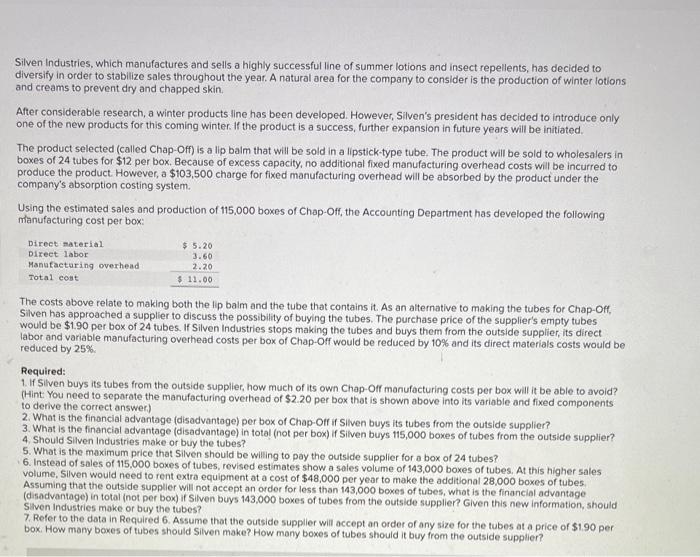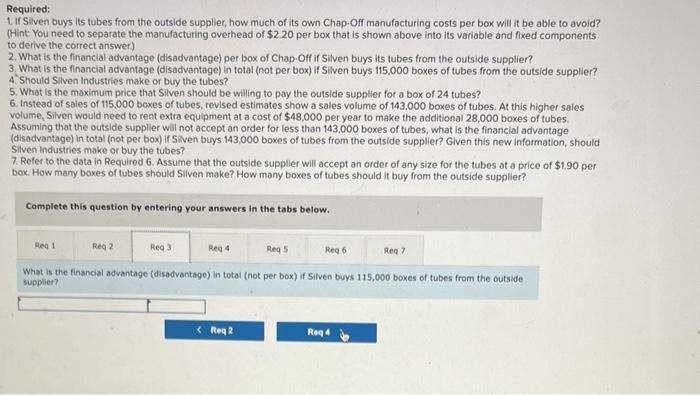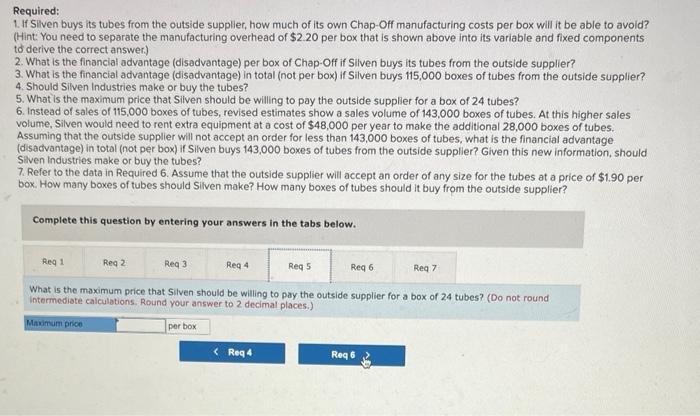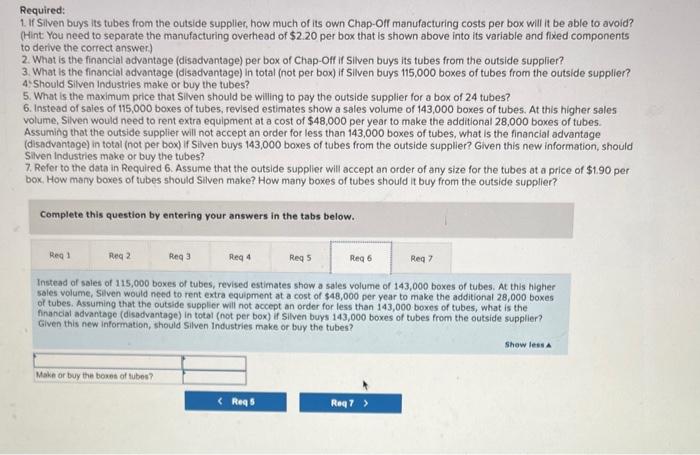Required:
1. If Silven buys its tubes from the outside supplier, how much of its own Chap-Off manufacturing costs per box will it be able to avoid? (Hint: You need to separate the manufacturing overhead of $2.20 per box that is shown above into its variable and fixed components to derive the correct answer.)
2. What is the financial advantage (disadvantage) per box of Chap-Off if Silven buys its tubes from the outside supplier?
3. What is the financial advantage (disadvantage) in total (not per box) if Silven buys 115,000 boxes of tubes from the outside supplier?
4. Should Silven Industries make or buy the tubes?
5. What is the maximum price that Silven should be willing to pay the outside supplier for a box of 24 tubes?
6. Instead of sales of 115,000 boxes of tubes, revised estimates show a sales volume of 143,000 boxes of tubes. At this higher sales volume, Silven would need to rent extra equipment at a cost of $48,000 per year to make the additional 28,000 boxes of tubes. Assuming that the outside supplier will not accept an order for less than 143,000 boxes of tubes, what is the financial advantage (disadvantage) in total (not per box) if Silven buys 143,000 boxes of tubes from the outside supplier? Given this new information, should Silven Industries make or buy the tubes?
7. Refer to the data in Required 6. Assume that the outside supplier will accept an order of any size for the tubes at a price of $1.90 per box. How many boxes of tubes should Silven make? How many boxes of tubes should it buy from the outside supplier?
Silven Industries, which manufactures and sells a highly successful line of summer lotions and insect repellents, has decided to diversify in order to stabilize sales throughout the year. A natural area for the company to consider is the production of winter lotions and creams to prevent dry and chapped skin. After considerable research, a winter products line has been developed. However, Silven's president has declided to introduce only one of the new products for this coming winter. If the product is a success, further expansion in future years will be initiated. The product selected (called Chap-Off) is a lip baim that will be sold in a lipstick-type tube. The product will be sold to wholesalers in boxes of 24 tubes for $12 per box. Because of excess capacity, no additional fixed manufacturing overhead costs will be incurred to produce the product. However, a $103,500 charge for fixed manufacturing overhead will be absorbed by the product under the company's absorption costing system. Using the estimated sales and production of 115.000 boxes of Chap-Off, the Accounting Department has developed the foliowing manufacturing cost per box: The costs above relate to making both the lip baim and the tube that contains it. As an alternative to making the tubes for Chap-Off, Silven has approached a supplier to discuss the possibility of buying the tubes. The purchase price of the supplier's empty tubes would be $1.90 per box of 24 tubes. If Silven Industries stops making the tubes and buys them from the outside supplier, its direct labor and variable manufacturing overhead costs per box of Chap-Off would be reduced by 10% and its direct materials costs would be reduced by 25% Required: 1. If Silven buys its tubes from the outside supplier, how much of its own Chap-Off manufacturing costs per box will it be able to avoid? (Hint You need to separate the manufacturing overhead of \$2.20 per box that is shown above into its variable and fixed components to derive the correct answer.) 2. What is the financial advantage (disadvantage) per box of Chap-Off if Silven buys its tubes from the outside supplier? 3. What is the financial advantage (disadvantage) in total (not per box) if Silven buys 115,000 boxes of tubes from the outside supplier? 4. Should Silven Industries make or buy the tubes? 5. What is the maximum price that Silven should be willing to pay the outside supplier for a box of 24 tubes? 6. Instead of sales of 115,000 boxes of tubes, revised estimates show a soles volume of 143,000 boxes of tubes. At this higher sales volume, Silven would need to rent extra equipment at a cost of $48,000 per year to make the additional 28,000 boxes of tubes. Assuming that the outside supplier will not accept an ordor for less than 143,000 boxes of the ades, what is the financial advantage (disadvantage) in total (not per box) if Silven buys 143,000 boxes of tubes from the outside supplier? Given this new information, should Sliven industries make or buy the tubes? 7. Refer to the data in Required 6. Assume that the outside supplier will accept an order of any size for the tubes at a price of $1.90 per box. How many boxes of tubes should Silven make? How many boxes of tubes should it buy from the outside supplier? Required: 1. If Silven buys its tubes from the outside supplier, how much of its own Chap-Off manufacturing costs per box will it be able to avoid? (Hint: You need to separate the manufacturing overhead of $2.20 per box that is shown above into its variable and fixed components to derive the correct answer) 2. What is the financial advantage (disadvantage) per box of Chap-Off if Silven buys its tubes from the outside supplier? 3. What is the financial advantage (disadvantage) in total (not per box) if Silven buys 115,000 boxes of tubes from the outside supplier? 4.Should Silven Industries make or buy the tubes? 5. What is the maximum price that Silven should be willing to pay the outside suppller for a box of 24 tubes? 6. Instead of sales of 115,000 boxes of tubes, revised estimates show a sales volume of 143,000 boxes of tubes. At this higher sales volume, Silven would need to rent extra equipment at a cost of $48,000 per year to make the additional 28,000 boxes of tubes. Assuming that the outside supplier will not accept an order for less than 143.000 boxes of tubes, what is the financial advantoge (disadvantage) in total (not per box) if Silven buys 143,000 boxes of tubes from the outside supplier? Given this new information, should Silven industries make or buy the tubes? 7. Refer to the data in Required 6. Assume that the outside supplier will accept an order of any size for the tubes at a price of $1,90 per box. How many boxes of tubes should Silven make? How many boxes of tubes should it buy from the outside supplier? Complete this question by entering your answers in the tabs below. If 5 liven buys its tubes from the outside supplier, how much of its own Chap. Oif manufacturing costs per box will it be able to avoid? (Hint: You need to separate the manufacturing overhead of $2.20 per box that is shown above into its variable and fixed components to derive the correct answer.) (Do not round intermediate calculations, Round your answer to 2 decimal places.) Required: 1. If Silven buys its tubes from the outside supplier, how much of its own Chap-Off manufacturing costs per box will it be able to-avoid? (Hint: You need to separate the manufacturing overhead of $2.20 per box that is shown above into its variable and fixed components to derive the correct answer.) 2. What is the financial advantage (disadvantage) per box of Chap-Off if Silven buys its tubes from the outside supplier? 3. What is the financial advantage (disadvantage) in total (not per box) if Silven buys 115,000 boxes of tubes from the outside supplier? 4. Should Silven industries make or bury the tubes? 5. What is the maximum price that Sliven should be willing to pay the outside supplier for a box of 24 tubes? 6. Instead of sales of 115,000 boxes of tubes, revised estimates show a sales volume of 143,000 boxes of tubes. At this higher sales volume, Silven would need to rent extra equipment at a cost of $48,000 per year to make the additional 28,000 boxes of tubes. Assuming that the outside supplier will not accept an order for less than 143,000 boxes of tubes, what is the financial advantage (disadvantage) in total (not per box) if Sliven buys 143,000 boxes of tubes from the outside supplier? Given this new information, should Silven Industries make or buy the tubes? 7. Refer to the data in Required 6. Assume that the outside 5 upplier will accept an order of any size for the tubes at a price of $1.90 per box. How many boxes of tubes should Silven make? How many boxes of tubes should it buy from the outside supplier? Complete this question by entering your answers in the tabs below. What is the financial advantage (disadvantage) per box of Chap-Off if Silven buys its tubes from the outside supplier? (Do not round intermediate calculations. Round your answer to 2 decimal places.) Required: 1. If Silven buys its tubes from the outside supplier, how much of its own Chap-Off manufacturing costs per box will it be able to avoid? (Hint: You need to separate the manufacturing overhead of $2.20 per box that is shown above into its variable and fixed components to derive the correct answer.) 2. What is the financial advantage (disadvantage) per box of Chap-Off if Silven buys its tubes from the outside supplier? 3. What is the financial advantage (disadvantage) in total (not per box) if Silven buys 115.000 boxes of tubes from the outside supplier? 4. Should Silven Industries make or buy the tubes? 5. What is the maximum price that Silven should be willing to pay the outside supplier for a box of 24 tubes? 6. Instead of sales of 115,000 boxes of tubes, revised estimates show a sales volume of 143,000 boxes of tubes. At this higher sales volume, Silven would need to rent extra equipment at a cost of $48,000 per year to make the additional 28,000 boxes of tubes. Assuming that the outside supplier will not accept an order for less than 143.000 boxes of tubes, what is the financial advantage (disadvantage) in total (not per box) if Silven buys 143,000 boxes of tubes from the outside supplier? Glven this new information, should Silven industries make or buy the tubes? 7. Refer to the data in Required 6. Assume that the outside supplier will accept an order of any size for the tubes at a price of $1.90 per box. How many boxes of tubes should Silven make? How many boxes of tubes should it buy from the outside supplier? Complete this question by entering your answers in the tabs below. What is the financial advantage (disadvantage) in total (not per box) if Silven buys 115,000 boxes of tubes from the outside supplier? Reauifed: 1. If Siven buys lis tubes from the outside supplier, how much of its own Chap. Off manufacturing costs per box will it be able to avoid? (Hint:You need to separate the manufacturing overhead of $2.20 per box that is shown above into its variable and fixed components ta derive the correct answer] 2. What is the financial advantage (disadvantage) per box of Chap-Off if Sllven buys its tubes from the outside supplier? 3. What is the financial advantage (disadvantage) in total (not per box) if Silven buys 115,000 boxes of tubes from the outside 5 upplier? 4. Should Slven Industries make of buy the tubes? 5. What.is the maximum price that Sliven should be willing to pay the outside supplier for a box of 24 tubes? 6. Instead of sales of 115,000 boxes of tubes, revised estimates show a sales volume of 143,000 boxes of tubes. At this higher sales volume, Sliven would need to rent extra equipment at a cost of $48,000 per year to make the additional 28,000 boxes of tubes. Assuming that the outside supplier will not accept an order for less than 143,000 boxes of tubes, what is the financial advantage (disadvantage) in total (not per box) if Silven burys 143,000 boxes of tubes from the outside supplier? Given this new information, should Silven Industries make or buy the fubes? 7. Refer to the data in Required 6. Assume that the outside supplier will accept an order of any size for the tubes at a price of $1.90 per box. How many boxes of tubes should Slven make? How many boxes of tubes should it buy from the outside supplier? Complete this question by entering your answers in the tabs below. Shiuld Silven industries make or buy the tubes? Required: 1. If Sllven buys its tubes from the outside supplier, how much of its own Chap-Off manufacturing costs per box will it be able to avoid? (Hint: You need to separate the manufacturing overhead of $2.20 per box that is shown above into its variable and fixed components to derive the correct answer.) 2. What is the financial advantage (disadvantage) per box of Chap-Off if Silven buys its tubes from the outside supplier? 3. What is the financial advantage (disadvantage) in total (not per box) if Silven buys 115,000 boxes of tubes from the outside supplier? 4. Should Silven Industries make or buy the tubes? 5. What is the maximum price that Silven should be willing to pay the outside supplier for a box of 24 tubes? 6. Instead of sales of 115,000 boxes of tubes, revised estimates show a sales volume of 143,000 boxes of tubes. At this higher sales volume, Silven would need to rent extra equipment at a cost of $48,000 per year to make the additional 28,000 boxes of tubes. Assuming that the outside supplier will not accept an order for less than 143,000 boxes of tubes, what is the financial advantage (disadvantage) in total (not per box) if Silven buys 143,000 boxes of tubes from the outside supplier? Given this new information, should Slven Industries make or buy the tubes? 7. Refer to the data in Required 6. Assume that the outside supplier will accept an order of any size for the tubes at a price of $1.90 per box. How many boxes of tubes should Sliven make? How many boxes of tubes should it buy from the outside supplier? Complete this question by entering your answers in the tabs below. What is the maximum price that Siven should be willing to pay the outside supplier for a box of 24 tubes? (Do not round intermediate caiculations. Round your answer to 2 decimal places.) Required: 1. If Silven buys its tubes from the outside supplier, how much of its own Chap-Oif manufacturing costs per box will it be able to avoid? (Hint You need to separate the manufacturing overhead of $2.20 per box that Is shown above into its variable and fixed components to derive the correct answer) 2. What is the financial advantage (disadvantage) per box of Chap-Off if Sllven buys its tubes from the outside supplier? 3. What is the financial advantage (disadvantage) in total (not per box) if Sllven buys 115,000 boxes of tubes from the outside supplier? 4.Should Sliven industries make or buy the tubes? 5. What is the maximum price that Slven should be willing to pay the outside supplier for a box of 24 tubes? 6. Instead of sales of 115,000 boxes of tubes, revised estimates show a sales volume of 143,000 boxes of tubes. At this higher sales volume, Silven would need to rent extra equipment at a cost of $48,000 per year to make the additional 28,000 boxes of tubes. Assuming that the outside supplier will not accept an order for less than 143,000 boxes of tubes, what is the financial advantage (disadvantage) in total (not per box) if Silven buys 143,000 boxes of tubes from the outside supplier? Given this new information, should Silven industries make or buy the tubes? 7. Refer to the data in Required 6 . Assume that the outside supplier will accept an order of any size for the tubes at a price of $1.90 per box. How meny boxes of tubes should Slven make? How many boxes of tubes should it buy from the outside supplier? Complete this question by entering your answers in the tabs below. Instead of sales of 115,000 boxes of tubes, revised estimates show a sales volume of 143,000 boxes of tubes. At this higher 5ales volume, Silven would need to rent extra equipment at a cost of $48,000 per year to make the additional 28,000 boxes of tubes. Assuming that the outside supplier will not accept an order for less than 143,000 boxes of tubes, what is the francial advantage (disadvantage) in total (not per box) if Silven buys 143,000 boxes of tubes from the outside supplier? Given this new information, should Silven industries make or bry the tubes? Required: 1. If Silven buys its tubes from the outside supplier, how much of its own Chap-Off manufacturing costs per box will it be able to avold? (Hint: You need to separate the manufacturing overhead of \$2.20 per box that is shown above into its variable and fixed components to derive the correct answer.) 2. What is the financial advantage (disadvantage) per box of Chap-Off if Silven buys its tubes from the outside supplier? 3.What is the financial advantage (disadvantage) in total (not per box) if Silven buys 115,000 boxes of tubes from the outside supplier? 4. Should Silven Industries make or buy the tubes? 5. What is the maximum price that Silven should be willing to pay the outside supplier for a box of 24 tubes? 6. Instead of sales of 115,000 boxes of tubes, revised estimates show a sales volume of 143,000 boxes of tubes. At this higher sales volume; Silven would need to rent extra equipment at a cost of $48,000 per year to make the additional 28,000 boxes of tubes. Assuming that the outside supplier will not accept an order for less than 143,000 boxes of tubes, what is the financial advantage (disadvantage) in total (not per box) if Silven buys 143,000 boxes of tubes from the outside supplier? Given this new information, should Silven industries make or buy the tubes? 7. Refer to the data in Required 6 . Assume that the outside supplier will accept an order of any size for the tubes at a price of $1.90 per box. How many boxes of tubes should Silven make? How many boxes of tubes should it buy from the outside supplier? Complete this question by entering your answers in the tabs below. Refer to the data in Required 6. Assume that the outside supplier will accept an order of any size for the tubes at a price of $1.90 per box. How many boxes of tubes should Silven make? How many boxes of tubes should it buy from the outside supplier? (Round your intermediate calculations to 2 decimal places.)














